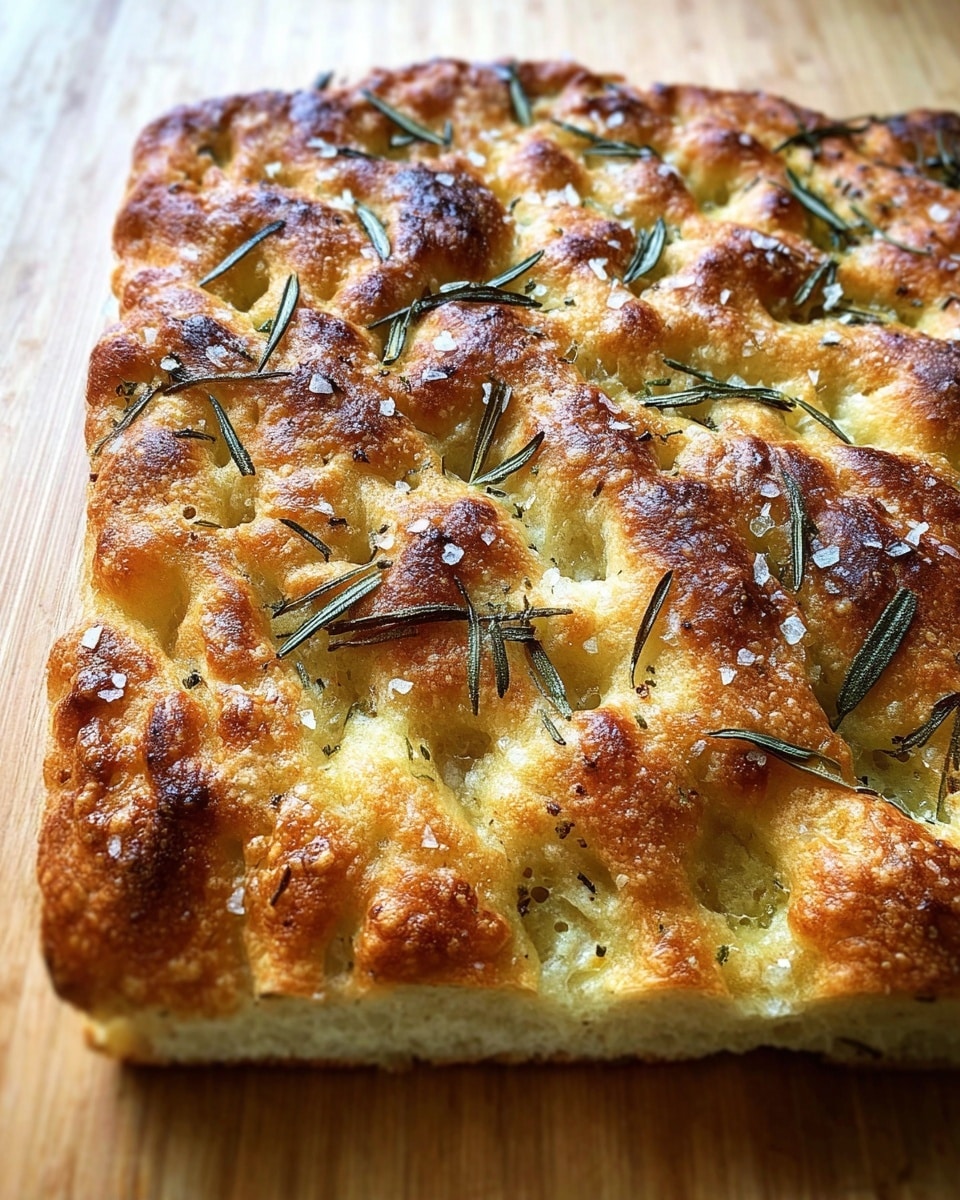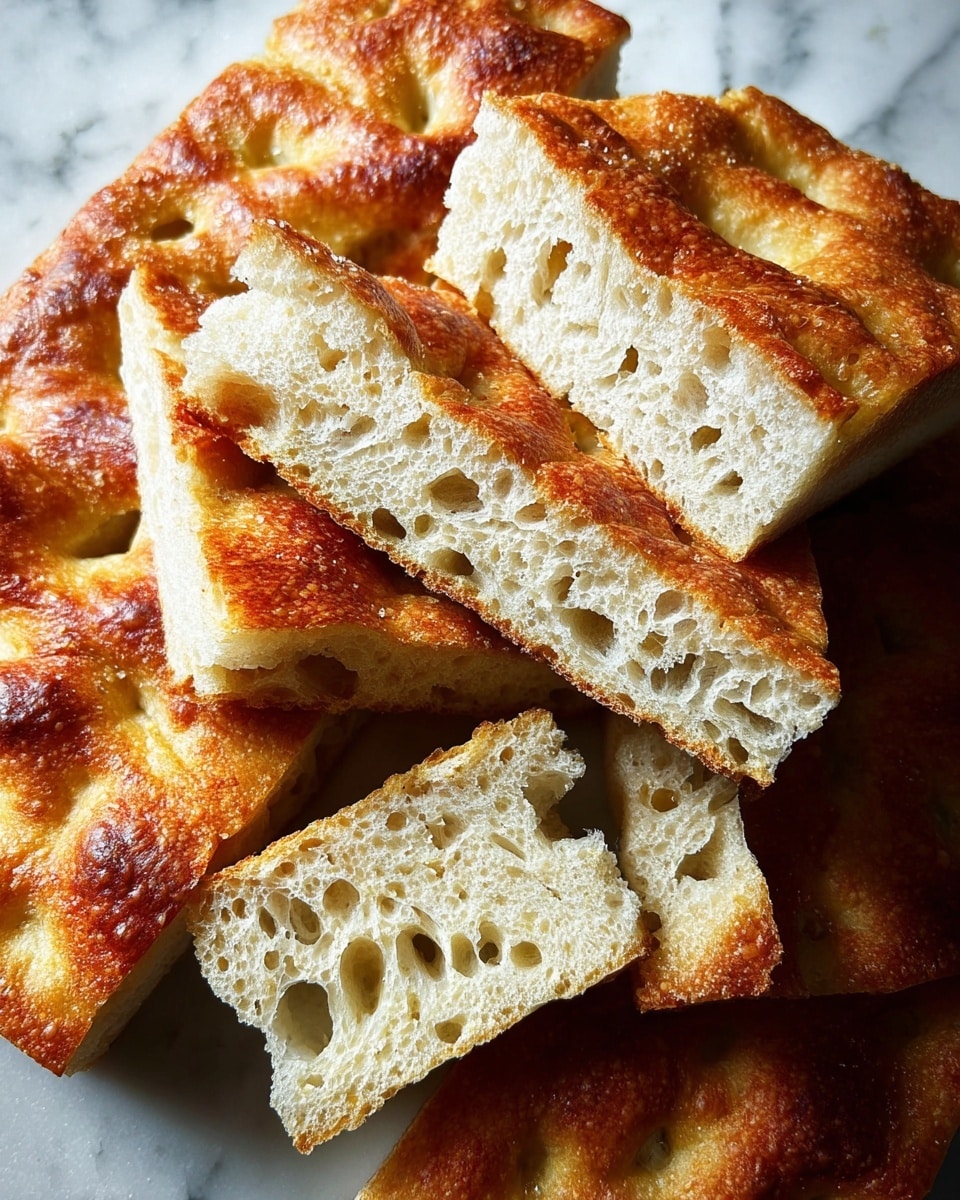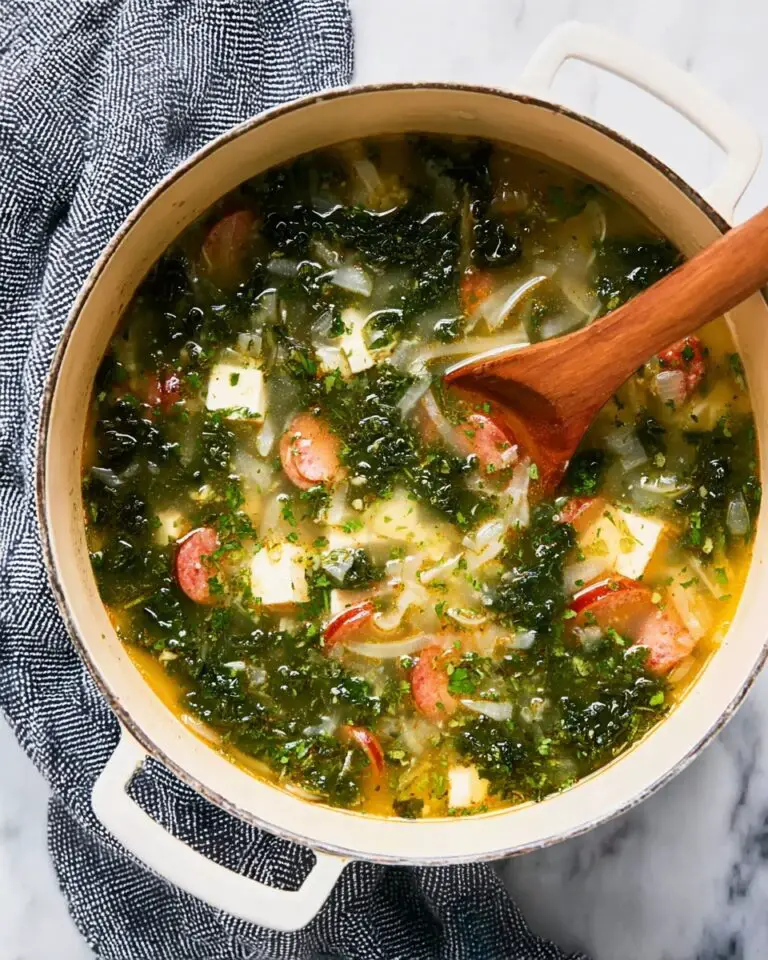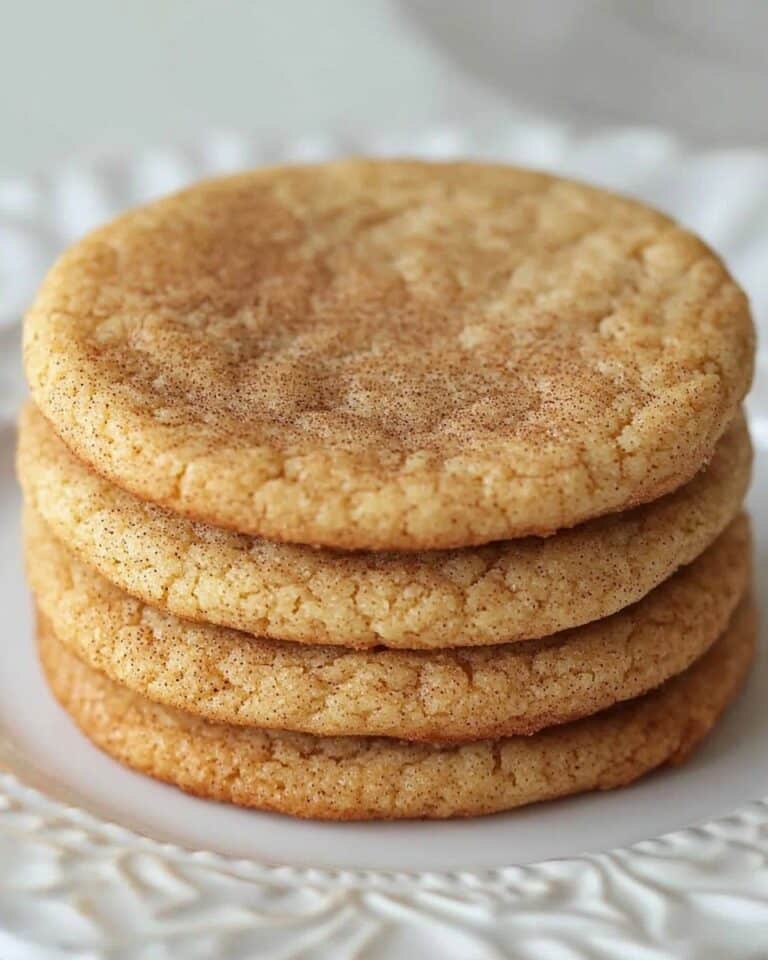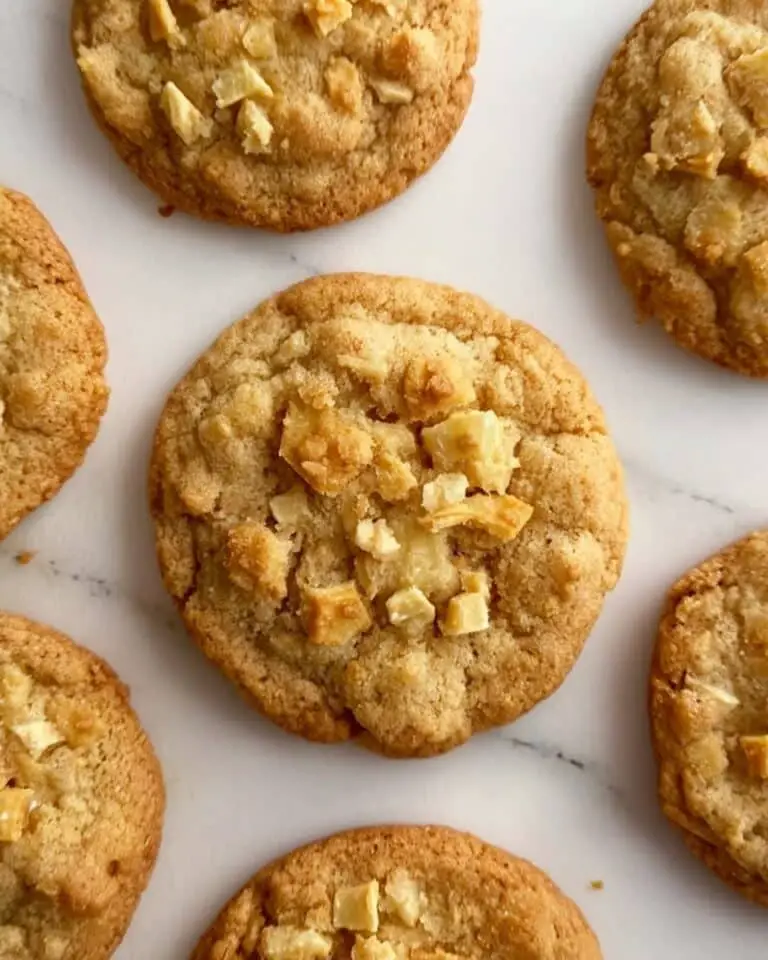I absolutely love sharing The Best, Easiest Focaccia Bread Recipe with you because it’s one of those magical breads that makes your kitchen smell like a cozy bakery. This focaccia is beautifully golden, crispy on the outside, and tender and airy on the inside — basically everything you want in a homemade bread without complicated techniques. Whether you’re making it for a weeknight dinner or an impressive weekend gathering, this recipe fits perfectly into any occasion.
When I first tried this recipe, I was blown away by how simple it was and yet how professional the results looked. The slow rise in the fridge develops flavor in such a lovely way, and the olive oil-dimpled crust with flaky sea salt and optional rosemary just melts in your mouth. I promise, once you try The Best, Easiest Focaccia Bread Recipe, you’ll keep coming back to it for everything from sandwiches to a simple accompaniment to soup or salad.
Why You’ll Love This Recipe
- Simple Ingredients: Uses everyday pantry staples that you probably already have on hand.
- Hands-Off Technique: The overnight rise means less active work and more rewarding flavor.
- Versatile and Flavorful: Easy to customize with herbs, toppings, or as a base for sandwiches.
- Consistent Results: Even if you’re new to baking bread, this recipe keeps things foolproof and delicious.
Ingredients You’ll Need
This focaccia recipe is fantastic because of the simple, classic ingredients all working together to create a complex flavor and texture. I recommend using bread flour if you want that chewy crumb, but all-purpose flour works great too. Here are some key notes on what to look for when shopping:
- All-purpose or Bread Flour: Bread flour gives a chewier texture thanks to higher protein, but use what you have—both work well here.
- Kosher Salt: I prefer kosher salt for better control and less density than table salt, but just adjust according to taste.
- Instant Yeast: Instant yeast speeds things up and mixes well; if you use active dry, just activate it first with a bit of lukewarm water.
- Lukewarm Water: The water should be warm but not hot — about body temperature — so the yeast wakes up without getting killed.
- Olive Oil: This adds the signature richness and creates that luscious golden crust when drizzled liberally.
- Flaky Sea Salt: Like Maldon — perfect for sprinkling on top to get those crunchy bursts of saltiness.
- Fresh Rosemary Leaves (Optional): I love adding rosemary for an herby, Mediterranean twist, but it’s totally optional and just as tasty plain.
Variations
I like to get creative with this focaccia and tailor it depending on the season or mood — and I encourage you to do the same! This recipe is very forgiving, so swapping out herbs or adding toppings is a fun way to make it your own.
- Herbed Focaccia: I often add a mix of rosemary and thyme for an earthy, fragrant loaf—so good with olive oil for dipping.
- Garlic Lover’s Version: Press thin slices of garlic into the dough before baking for a garlicky punch that my family goes crazy for.
- Cheese Topping: Sprinkle grated Parmesan or mozzarella before baking to add a golden, melty crust—perfect as a snack or side.
- Gluten-Free Adaptation: While I haven’t perfected a gluten-free version yet, you could experiment with gluten-free flour blends, keeping hydration in mind.
How to Make The Best, Easiest Focaccia Bread Recipe
Step 1: Whisk, Mix, and Let It Chill
Start by combining your flour, salt, and instant yeast in a large bowl — whisk them together to evenly distribute everything. Then pour in your lukewarm water and stir with a rubber spatula until the mixture forms a sticky dough ball. Here’s the trick I discovered: after mixing, rub the surface of the dough lightly with olive oil to keep it slick and prevent drying out. Cover it up and pop it straight into the fridge for at least 12 hours, up to three days. This slow, cold fermentation is what builds that deep flavor and wonderfully light texture without any kneading.
Step 2: Prepare Your Pan and Shape the Dough
Get your pans ready by lining two 8- or 9-inch pie plates or a 9×13-inch pan with parchment paper or greasing them generously with butter or cooking spray. This step might seem fussier than usual, but trust me, it saves you from battling stuck dough later. Pour a tablespoon or two of olive oil into each pan to coat the surface. Take your cold dough out and use two forks to gently deflate it — releasing it from the bowl edges and shaping it into a rough ball. If using two pans, divide the dough in half, then roll each piece in the olive oil to coat it well before placing it in its pan. Let the dough rest at room temperature for 3 to 4 hours until it puffs up — no cover necessary here.
Step 3: Oil, Dimple, and Bake
Preheat your oven to 425°F and position a rack in the center. If you’re adding rosemary, sprinkle it over the surface of the dough now. Pour more olive oil on top — about a tablespoon per pan — then, here’s a fun part: use your fingertips, coated in oil, to press deep dimples all over the dough. This is what gives focaccia its characteristic bubbly texture and pockets that soak up the olive oil. If the dough resists, gently stretch it to fill the pan. Sprinkle flaky sea salt all over, then slide your pans into the oven.
Bake for 25 to 30 minutes until the bottom is golden and crisp. When it’s out, transfer the focaccia to a cooling rack and let it rest for 10 minutes before slicing. If you’re using this for sandwiches, it’s best to let it cool completely before cutting—trust me on this for neat slices.
Pro Tips for Making The Best, Easiest Focaccia Bread Recipe
- Use Olive Oil Liberally: Don’t be shy adding olive oil to the dough and the pan—it’s key to that crisp outside and moist crumb.
- Cold Fermentation Works Wonders: Overnight fridge time lets the dough develop better flavor with almost no effort.
- Dimples Are Essential: Press deep dimples firmly but gently so the dough settles—not flattens—and traps olive oil beautifully.
- Don’t Skip the Salting: Flaky sea salt on top is what turns good focaccia into unforgettable focaccia.
How to Serve The Best, Easiest Focaccia Bread Recipe
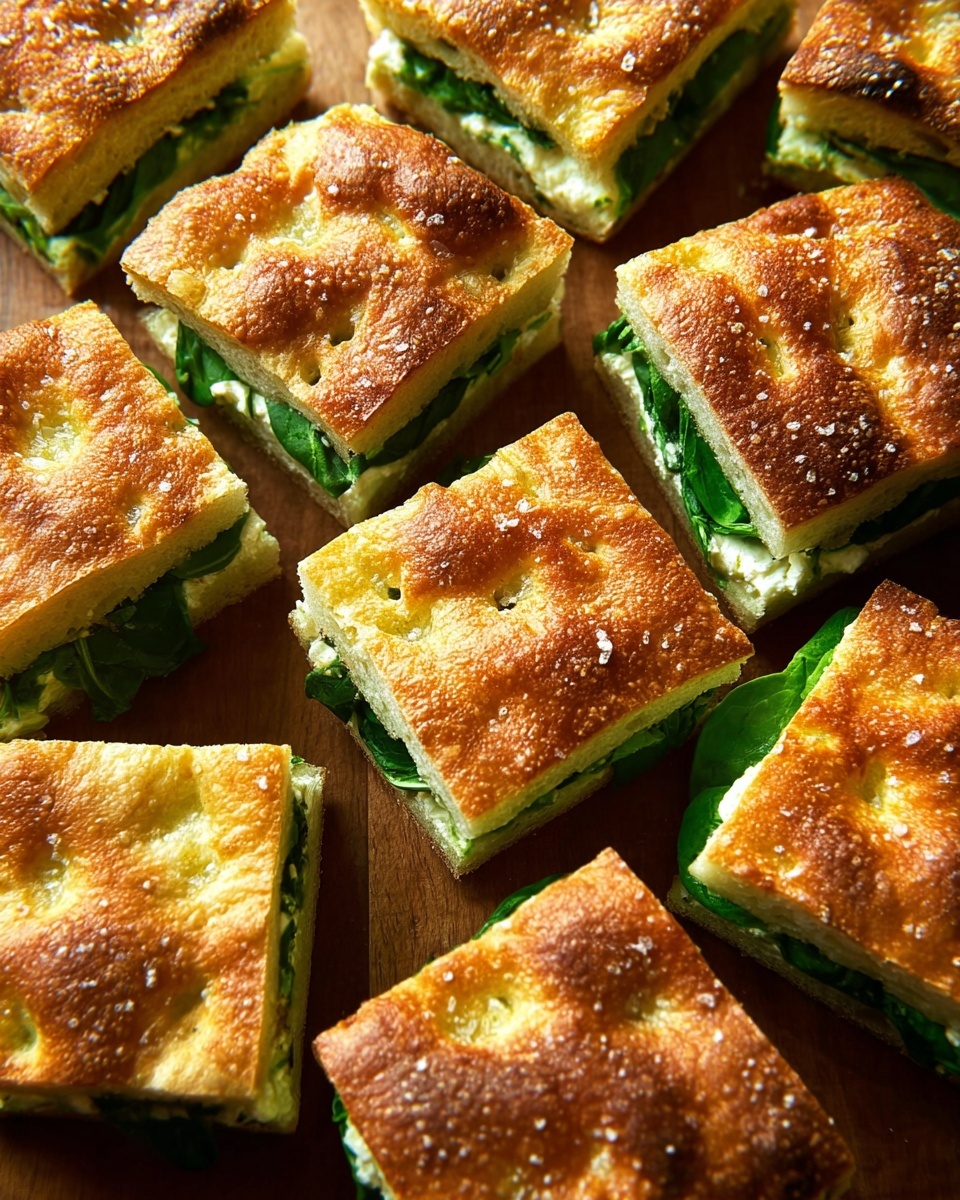
Garnishes
I love finishing my focaccia with a sprinkle of flaky sea salt and fresh rosemary — it’s simple but elevates the bread into something really special. Sometimes I also add thinly sliced olives or cherry tomatoes just before baking for an extra pop of color and flavor. Another favorite is a light drizzle of good-quality extra virgin olive oil right after it comes out of the oven.
Side Dishes
This focaccia pairs beautifully with almost anything. My family’s favorite is alongside a fresh green salad, robust tomato soup, or a simple charcuterie board. I also love using it to make sandwiches filled with roasted vegetables, sliced meats, or creamy cheeses.
Creative Ways to Present
For special occasions, I sometimes cut the focaccia into mini squares or strips and serve them with flavored olive oils and balsamic vinegar for dipping. Another fun idea: top the focaccia with caramelized onions, roasted garlic, and sun-dried tomatoes before baking, making it a show-stopping centerpiece that looks as amazing as it tastes.
Make Ahead and Storage
Storing Leftovers
Once your focaccia has completely cooled, I wrap it tightly in plastic wrap or place it in an airtight container and keep it at room temperature. It stays fresh and delicious for up to 3 days this way. I find this method retains the lovely softness of the crumb without drying it out.
Freezing
If you want to save some for later, freezing works great! I slice the focaccia first, then wrap each piece or the whole loaf carefully in plastic wrap and foil to protect against freezer burn. It can last up to 3 months, which makes it perfect for batch baking.
Reheating
When you’re ready to enjoy your focaccia leftovers, I reheat it in a preheated 350ºF oven for about 15 minutes on a baking sheet. This refreshes that crisp crust and revives the soft interior like it’s freshly baked. Avoid microwaving if you want to keep that texture!
FAQs
-
Can I skip the overnight rise in the fridge?
You can do a same-day focaccia by letting the dough rise at room temperature for a few hours instead of overnight in the fridge. However, the flavor won’t be as developed, and the texture may be less airy. The slow cold fermentation really enhances the bread, so whenever possible, I recommend sticking with the overnight chill.
-
What’s the difference between instant yeast and active dry yeast here?
Instant yeast can be mixed directly with the dry ingredients and acts faster, while active dry yeast needs to be activated in warm water before adding. If you only have active dry, just dissolve it in part of the lukewarm water with a pinch of sugar and wait until it bubbles before mixing into the dough.
-
Why do I have to oil the dough’s surface before refrigerating?
Oiling the dough surface creates a moisture barrier that prevents it from drying out and forming an unwanted crust. If you skip this step, especially when covering the bowl with a towel instead of plastic wrap, the dough can develop a tough skin, affecting the texture of your focaccia.
-
Can I add other toppings besides rosemary?
Absolutely! The recipe is very flexible—try olives, cherry tomatoes, caramelized onions, or even thinly sliced garlic. Just press them gently into the dough before baking for a delicious twist that suits your taste.
Final Thoughts
I truly believe The Best, Easiest Focaccia Bread Recipe is a game-changer for anyone wanting to bake bread that feels special but isn’t intimidating. It’s one of those comforting recipes I keep coming back to not only because it tastes amazing but also because it fits so well into my busy life — slow ferment overnight, quick hands-on prep, and joyful results. I can’t wait for you to try it yourself and see how this simple, olive oil-rich bread can become your new favorite kitchen staple.
Print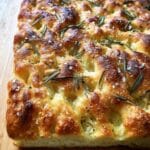
The Best, Easiest Focaccia Bread Recipe
- Prep Time: 15 minutes
- Cook Time: 30 minutes
- Total Time: 18 hours 45 minutes
- Yield: 2 loaves
- Category: Bread
- Method: Baking
- Cuisine: Italian
Description
This Best, Easiest Focaccia Bread Recipe yields a delightfully fluffy and aromatic Italian flatbread with a crispy golden crust, perfect for sandwiches or as an accompaniment to meals. Made with simple pantry staples and an effortless overnight fermentation, this focaccia is infused with olive oil and optionally fragrant rosemary, sprinkled with flaky sea salt for an authentic texture and flavor.
Ingredients
Dough Ingredients
- 4 cups (512 g) all-purpose flour or bread flour
- 2 to 3 teaspoons (10 to 15 grams) kosher salt
- 2 teaspoons (8 g) instant yeast
- 2 cups (455 g) lukewarm water (made by combining 1/2 cup boiling water with 1 1/2 cups cold water)
Additional Ingredients
- Butter for greasing pans
- 4 tablespoons olive oil, divided
- Flaky sea salt, such as Maldon, for sprinkling
- 1 to 2 teaspoons whole rosemary leaves (optional)
Instructions
- Make the dough: In a large bowl, whisk together the flour, kosher salt, and instant yeast until well combined. Add the lukewarm water to the dry ingredients. Using a rubber spatula, mix until all the liquid is absorbed and a sticky dough ball forms. Rub the surface of the dough lightly with olive oil to prevent drying. Cover the bowl securely with a damp tea towel, cloth bowl cover, or plastic wrap, and place it immediately in the refrigerator for at least 12 hours and up to 3 days to ferment slowly, which enhances flavor and texture.
- Prepare baking pans: Line two 8- or 9-inch pie plates or one 9×13-inch pan with parchment paper or grease thoroughly with butter or nonstick cooking spray to prevent sticking, especially if using glass or non-olive oil proof pans. Pour about a tablespoon of olive oil into each pan (or two tablespoons if using the larger 9×13 pan).
- Deflate and divide dough: Using two forks, gently deflate the dough by pulling it away from the sides of the bowl toward the center, rotating the bowl as you work. This releases gas and redistributes the yeast. Split the dough into two equal pieces for two pans or keep whole for the 9×13 pan. Place each dough ball into its prepared pan, rolling it in the oil to coat fully and forming a rough ball shape. Let the dough balls rest uncovered at room temperature for 3 to 4 hours to allow them to rise and come to room temperature.
- Preheat oven and prepare dough surface: Place an oven rack in the middle and preheat your oven to 425°F (218°C). If using rosemary, sprinkle the whole rosemary leaves evenly over the dough now. Drizzle a tablespoon of olive oil over each round of dough (two tablespoons if using the larger pan). Rub your hands lightly in olive oil and use your fingertips to press straight down on the dough to create deep dimples all over the surface. Gently stretch the dough if necessary to fill the pan fully. Finally, sprinkle generous flaky sea salt across the top for texture and flavor.
- Bake the focaccia: Transfer the pans to the preheated oven and bake for 25 to 30 minutes, until the focaccia turns golden brown on the bottom and has a crisp crust with a tender interior.
- Cool and serve: Remove the focaccia from the oven and transfer it to a cooling rack. Allow it to cool for at least 10 minutes before cutting to serve. If planning to make sandwiches, let it cool completely for easier slicing.
- Storage: Once completely cooled, store the focaccia in an airtight bag or container at room temperature for up to 3 days. For longer storage, freeze focaccia for up to 3 months. To revive crispness when reheating, bake at 350°F (177°C) for 15 minutes before serving.
Notes
- The long cold fermentation in the refrigerator (at least 12 hours) develops flavor and improves the bread’s texture but can be shortened if necessary; reduce fermentation times to achieve quicker results with some loss of flavor complexity.
- If using active dry yeast instead of instant yeast, proof the yeast in warm water before mixing with flour.
- Greasing pans thoroughly is critical to prevent sticking; butter is especially recommended for glass pans.
- Olive oil on the dough surface prevents drying during refrigerator fermentation, especially when using cloth covers instead of plastic wrap.
- Flaky sea salt adds a pleasant crunch and bursts of saltiness; do not substitute with fine table salt.
- Rosemary leaves are optional but provide a classic, fragrant flavor that complements the olive oil.
- For best crust texture on reheating, avoid microwaving as it softens the crust.
Nutrition
- Serving Size: 1 slice (approximately 1/12 of a loaf)
- Calories: 210
- Sugar: 0.4 g
- Sodium: 320 mg
- Fat: 8 g
- Saturated Fat: 1 g
- Unsaturated Fat: 7 g
- Trans Fat: 0 g
- Carbohydrates: 29 g
- Fiber: 1.5 g
- Protein: 5 g
- Cholesterol: 0 mg

